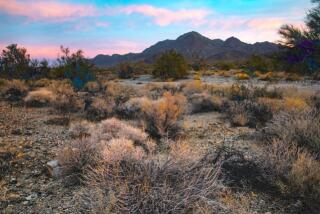Oregon: Remote prairie grasslands named national natural landmark
- Share via
The lonely Zumwalt Prairie Preserve in the northeast corner of Oregon features thousands of acres of native grasslands. It’s not easy to get to, and less than 500 people a year visit, but it’s an important place because it represents one of the country’s vanishing landscapes.
The National Park Service on Tuesday announced the designation of the preserve as a national natural landmark, singling it out as the best example of bunchgrass prairie that still stands.
“It’s a great honor to be recognized as one of the best remaining examples of this type of landscape,” says Jeff Fields, northeast Oregon project director for the Nature Conservancy.
The natural landmark designation doesn’t come with any funding, but it acknowledges the importance of preserving landscapes that once were common in the United States.
The park service also designated the Wade Tract Preserve in Georgia as a national landmark as one of the last stands of longleaf pines.
The landmark designation for the Zumwalt preserve in Oregon covers 4,400 acres of the conservancy’s 33,000 acres in Wallowa County. It’s a working landscape that includes cattle grazing, a practice that dates to the early settlers.
The preserve is surrounded by privately owned parcels where ranchers work the land too.
To visit, you drive 20 miles down a gravel road. Once you arrive, you can hike about six miles of rolling trails to see eagles and hawks, wildflowers and of course the grasses that define the area.
Fields describes the trails as rustic -- no water, no bathrooms, no graded trail beds. “You’re essentially walking across the prairie” as it has always been, Fields says.
What you see also depends on when you go. In May and June, visitors will see flowering plants at the height of color. In late summer and fall, herds of elk will be more visible.
And the prairie has another distinction too. Researchers have documented more than 100 species of native bees. “There’s very little presence of the introduced honeybee,” Fields says. “It’s a pretty neat thing to have this remnant of native grassland out there that can support native flora and fauna.”
The preserve is close to other natural areas such as Hells Canyon on the Oregon-Idaho border, and Wallowa Lake, a six-mile long glacier lake surrounded by high peaks.
To visit, go to Zumwalt Prairie Preserve for directions and hiking guidelines.
Follow us on Twitter @latimestravel, like us on Facebook @Los Angeles Times Travel.
More to Read
Sign up for The Wild
We’ll help you find the best places to hike, bike and run, as well as the perfect silent spots for meditation and yoga.
You may occasionally receive promotional content from the Los Angeles Times.







